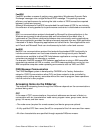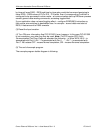
Klinkmann Automation Omron Ethernet DAServer 5
Omron Ethernet DAServer Ver 1.x User Manual Rev 1.3 17014m13
To access an OPC item, the OPC client needs to connect to the DAServer (either in-
process or out-of-process) and create an OPC group defining the data-acquisition
properties for the collection of items to be added. OPC groups
can be either public or private. Public OPC groups are shared across multiple clients,
whereas private OPC groups are local to a single client. Optionally, a device group, which
indicates the access path to the items for read/write, can
be specified from the DAServer.
The following briefly describes each characteristic of the OPC protocol:
• node name: Computer (host) name identifying a specific node on the network (for
Remote Access ONLY).
• program name: The registered OPC server name uniquely identifying a specific server
(ProgID). For this DAServer, the program name is ArchestrA.OmronEth.1.
• group name: The OPC group created from the client for organizing a collection of items
logically with the same data acquisition properties between the client and the server, such
as update rate.
• device group: Meaningful names configured in the DAServer under a specific controller
for the common custom attributes between the DAServer and the device, such as update
interval. If not specified from the client, the default device group using the global
configuration attribute values from the DAServer is assumed. Functionally, a device group
is equivalent to an access path (optional).
• link name: The set of hierarchy node names, representing the specific devices on a
communications path link from the hierarchy root to a specific controller as configured for
this DAServer under the DAServer Manager, separated by delimiters.
• item name: A specific data element, the leaf of the hierarchy tree of this DAServer,
within the specified group. For example, when using this DAServer, an item can be a
relay, timer, counter, register, and so on, in the controller.
DDE/SuiteLink
In the case of DDE/SuiteLink communications, the protocol addresses an element of data
in a conversation that uses a four-part naming convention that includes the node name,
application name, topic name, and item name. The fully qualified DDE/SuiteLink naming
convention includes all four parts, although the node name part (required for remote
access only) is optional. The following briefly describes each portion of this naming
convention:
• node name: Computer (host) name identifying a specific node on the network (for
Remote Access ONLY).
• application name: The name of the Windows program (this DAServer) that will be
accessing the data element. In the case of data coming from or going to the Modicon
devices via the DDE/SuiteLink PlugIn of this DAServer, the application name portion of
the address is DASOmronEth.


















